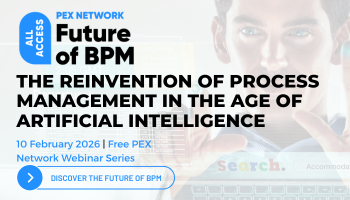The digital future of risk and compliance management
Regular columnist Helge Hess of Software AG explains why intelligent automation, process mining and a process-oriented approach are essential to minimizing compliance risk
Add bookmark
"Act only according to that maxim whereby you can, at the same time, will that it should become a universal law." — Immanuel Kant (1724-1804)
In the modern business world, companies face ever-increasing governance, risk management and compliance (GRC) demands. Effective GRC is a key factor in gaining the trust of investors, regulators and customers. In addition, penalties for non-compliance or errors in compliance implementation are increasing.
The number of compliance requirements has increased steadily in recent years. Organizations must now adhere to an ever-expanding list of national and international standards related to quality, data protection, IT security, sustainability, corruption and human rights amongst other areas. Keeping track of new regulations and proving compliance can be difficult and expensive.
In addition to the thematic breadth of compliance issues, another challenge lies in the rapidly growing volume of data generated by business transactions. In this scenario, the constantly increasing degree of automation of workflows and business processes presents a challenge and an opportunity.
Join the PEX Network community

Don't miss any news, updates or insider tips from PEX Network by getting them delivered to your inbox. Sign up to our newsletter and join our community of experts.
Learn MoreManual, incomplete and error-prone compliance processes will no longer suffice
The traditional approach of reviewing the effectiveness of a management system through periodic manual audits has many drawbacks and shortcomings. To start, manual sampling evaluates only a very small proportion of the total process volume and therefore has limited informative value about the actual effectiveness of controls and compliance with rules. In addition, manual rechecking is labor-intensive and insufficient. Proactive intervention and the prevention of rule violations are not achieved in this way.
Streamline compliance with a process-oriented perspective
By establishing standardized, repeatable and cross-functional compliance processes, a process-oriented approach increases accuracy and efficiency. With regard to methodology, a number of best practices have emerged in recent years:
- A company's process map and core processes are the perfect navigation structures to get an overview of risks and compliance requirements.
- It is counterproductive to build a separate management system for each compliance topic (quality, data protection, etc). The requirements are highly overlapping, so that an integrated management system (enterprise management system) that covers all topics is much more efficient.
- It is purposeful to consider risks and compliance requirements in the sense of 'compliance by design' already when defining the to-be processes.
Automate compliance management to boost efficiency
A number of new technologies are available that can massively increase the efficiency of enterprise risk and compliance management:
Process automation solutions unlock powerful advantages
First, the level of automation of processes is increasing exponentially as transformative technologies are deployed under the intelligent automation umbrella. Workflow systems control the end-to-end processing of processes while robotic processing automation (RPA) systems take over repetitive, manual tasks. Intelligent document processing (IDP) scans, extracts, and organizes meaningful information from text-based documents. Low-code and no-code platforms enable business users to automate processes and build applications with minimal help from IT.
Process mining technologies identify bottlenecks and areas of increased risks
Process mining technologies have become increasingly vital to compliance management in recent years. In addition to driving process optimization, the detection of deviations and compliance violations has emerged as an important use case.
Process mining analyzes the processing of each individual operation and provides insight into as-is end-to-end processes. In this way, compliance violations can be identified and remediated. By analyzing operations and data streams, process mining eliminates the main disadvantages of manual audits: instead of only random samples, the entirety of the processes are analyzed and interventions can occur in real-time.
Another important aspect of process mining in the context of GRC is the resulting transparency. A comprehensive visualization of process flows makes it possible to identify weaknesses and risks that might otherwise go undetected. Companies can thus take proactive measures to avoid risks and comply with rules, thereby avoiding compliance violations and potential sanctions and penalties.
Achieve proactive compliance with machine learning and artificial intelligence
Machine learning technologies are currently experiencing tremendous attention. There are also many new applications in the field of risk and compliance management. For one, artificial intelligence (AI) systems can identify patterns and deviations by analyzing large amounts of data and proactively point out potential compliance violations. In addition, they are able to automatically adapt to new compliance requirements and independently extract rules from legal texts.
These capabilities eliminate the need for employees to manually updating systems and improve the efficiency of compliance activities. In the near future, audits will be fully automated (i.e. from the analysis of all business transactions to the review of all relevant rules to the automated generation of reports) and hardly any manual intervention will be required.
Rapid advances in machine learning also bring regulatory challenges related to AI explainability. In order to verify all compliance requirements are followed, it is essential to understand how AI systems make decisions and perform tasks.
In summary, the future of risk and compliance management lies in the adoption of new technologies. These technologies can significantly increase the efficiency of enterprise risk and compliance management, reducing the burden on employees while improving compliance outcomes. Companies that embrace these new technologies will gain a competitive advantage, increase their trustworthiness and avoid penalties for non-compliance.
All Access: Future of BPM 2026

You asked, and we listened. Business process management (BPM) remains the cornerstone technology for driving organizational transformation, according to the survey results featured in the latest PEX Report. As we look toward 2026 and beyond, generative AI, agentic AI, and intelligent process orchestration are redefining how processes are designed, executed, and optimized. BPM is your key to adapting swiftly and effectively in this new era.
PEX Network is bringing together industry leaders, technology innovators, and thought leaders to answer your biggest questions and explore the advancements reshaping business today. And you're invited. Register for free to save your spot now!
Register Now




















